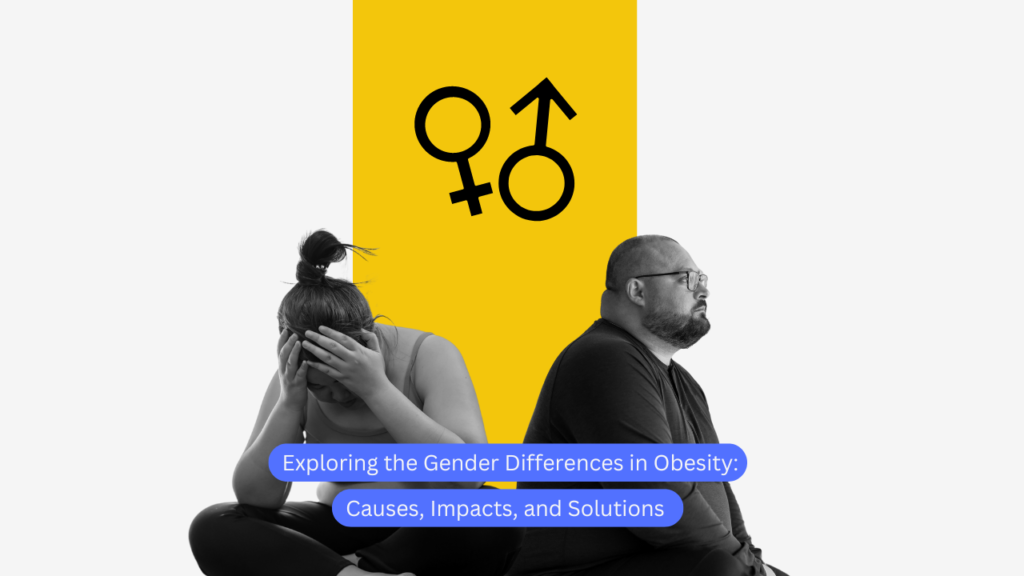
Mukta Wani
Bariatric Dietician & Content Writer
Exploring the Gender Differences in Obesity: Causes, Impacts, and Solutions

In terms of health, obesity is seen as a long-term condition caused by a variety of factors that contribute to an excessive accumulation of body fat in the body. Although it is normal to have a certain amount of body fat on your body, too much of it can interfere with how your body functions. In the long run, these changes can have a significant impact on one’s health and can be gradually exacerbated as time passes. If the body has too much fat, it can alter the normal functions of the body, making them more likely to become diabetic, to suffer from heart disease, and to suffer from other serious health complications.
What raises the risk of obesity?
Obesity is a complex issue with many causes.
General Cost:-
Obesity is a complex issue with many causes.
Lack of physical activity
Unhealthy eating
Drinking too much alcohol (as alcohol contains a lot of calories)
Health condition: Underlying medical conditions may contribute to weight gain.
Certain medicines: Like Steroids, Epilepsy, Diabetes, antidepressants etc.
Environment : In many cases obesity is more to do with environmental factors, for example not having easy access to healthy food, or unhealthy eating habits learned during childhood.
Sometimes genetics: There are some genes associated with obesity and being overweight. In some people, genes can affect how their bodies change food into energy and store fat. There are also some rare genetic conditions that can cause obesity, such as Prader-Willi syndrome.
Therefore, it is important to maintain a healthy balance of body fat in order to reduce the risk of serious health complications.
BMI is Body mass index, a valuable and easy to use tool to assess whether a person has a healthy weight or not, & it is derived from an individual’s weight and height.
The Formula is:
BMI = WEIGHT(kg)
HEIGHT(m)2
BMI Categories:
Underweight: IF BMI is less than 18.5
Normal weight : 18.5 – 24.9
Overweight: BMI 25 – 29.9
Obese: BMI 30 or greater.
Women are more frequently diagnosed with obesity as compared to men. As they have a higher percentage of fat content compared to men.
Obesity and fat can have different ways of presenting themselves in the bodies of males and females. The different shapes of men’s and women’s bodies are mainly due to how and where their bodies store fat, influenced by hormones and muscle mass. Understanding these differences helps in addressing health and fitness needs effectively.
There are two types of obesity ANDROID and GYNOID obesity.
ANDROID OBESITY: In men, obesity often shows up as fat around the belly (visceral fat) and the upper and middle back (thoracic region). Here’s a simple breakdown:
Belly: Men tend to store a lot of fat in the abdominal area, which is called visceral fat. This fat surrounds the internal organs and can be harmful to health.
Upper and Middle Back: Men also store fat in the thoracic region, which includes the upper and middle parts of the back.
Why Does This Happen???
Hormones: Men have higher testosterone levels, which influence fat storage in these areas.
Muscle Mass: Men typically have more muscle, which affects how and where fat is distributed.
Health Risks:
Visceral Fat: Fat around the belly is linked to a higher risk of heart disease, diabetes, and other health problems.
Back Fat: While less dangerous than visceral fat, excess fat in the back can still contribute to overall health risks.
GYNOID OBESITY: It is more commonly found in females. It can be characterized as a large amount of fat accumulation around the hips, breasts, and thighs. Person with gynoid type obesity has a pear-shaped body. Women naturally have higher body fat percentages due to hormonal differences and reproductive functions.
Here’s a simple breakdown:
Where Fat Shows Up in Women
Hips: Women tend to store fat around the hips.
Thighs: Fat accumulation is common in the thighs.
Buttocks: The buttocks also store a significant amount of fat.
Why This Happens
Hormones: Higher levels of estrogen in women promote fat storage in the lower body areas.
Genetics: Genetic factors also play a role in how fat is distributed.
Health Implications
Subcutaneous Fat: The fat stored in these areas is mostly subcutaneous, meaning it is just under the skin. It is less harmful compared to visceral fat, which is stored around the organs.
Lower Immediate Risk: While this type of fat is less risky in the short term, excess fat in any part of the body can still contribute to health issues over time.
Treatment:
Treating both android and gynoid obesity involves a combination of healthy lifestyle changes and, if necessary, medical interventions.
Focus on a balanced diet rich in fruits, vegetables, whole grains, lean proteins, and healthy fats while reducing sugary and processed foods, controlling portions, and increasing fiber intake.
Regular physical activity is crucial, including at least 150 minutes of moderate-intensity cardio or 75 minutes of high-intensity cardio per week, along with strength training twice a week and flexibility exercises like yoga.
Prioritize getting 7-9 hours of quality sleep, managing stress through mindfulness or hobbies, and staying hydrated.
Adopt healthy eating habits by eating mindfully, maintaining regular meals, and avoiding emotional eating, and seek support from friends, family, or groups.
If lifestyle changes aren’t enough, consult a healthcare provider for a personalized plan that may include medications or, in severe cases, surgical options like bariatric surgery.





